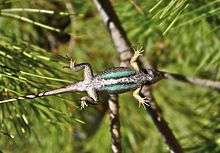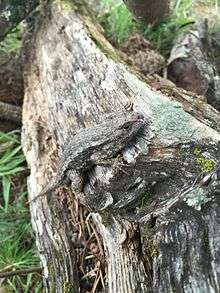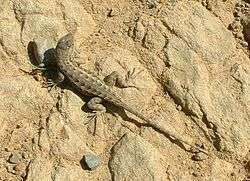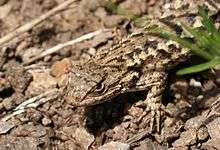Western fence lizard
| Western fence lizard | |
|---|---|
| S. o. taylori | |
| Scientific classification | |
| Kingdom: | Animalia |
| Phylum: | Chordata |
| Class: | Reptilia |
| Order: | Squamata |
| Suborder: | Iguania |
| Family: | Phrynosomatidae |
| Genus: | Sceloporus |
| Species: | S. occidentalis |
| Binomial name | |
| Sceloporus occidentalis | |
The western fence lizard (Sceloporus occidentalis) is a common lizard of Arizona, California, Idaho, Nevada, Oregon, Utah, Washington, Northern Mexico, and the surrounding area. As the ventral abdomen of an adult is characteristically blue, it is also known as the blue-belly.
It is a member of the genus Sceloporus (the spiny lizards).[1]
Taxonomy
Taxonomy for the western fence lizard has been under much debate. S. occidentalis belongs in the order Squamata (snakes and lizards) and the suborder Iguania. The family in which it belongs is still under scrutiny. The family Phrynosomatidae, along with seven other families, used to be included in the single family Iguanidae, until Frost and Etheridge's (1989) analysis of iguanian systematics suggested the family be divided.[2] Most literature, however, still place the phrynosomatids in Iguanidae.
Six subspecies are recognized, as follows:
- Island fence lizard, Sceloporus occidentalis becki
- San Joaquin fence lizard, Sceloporus occidentalis biseriatus
- Coast Range fence lizard, Sceloporus occidentalis bocourtii
- Great Basin fence lizard, Sceloporus occidentalis longipes
- Northwestern fence lizard, Sceloporus occidentalis occidentalis
- Sierra fence lizard, Sceloporus occidentalis taylori
Some authors have raised the island fence lizard to specific rank, Sceloporus becki. However, recent work in molecular systematics has suggested there are four clades and 11 genetically separable populations, and the subspecies will probably have to be redefined.[1]
Identification

Western fence lizards measure 5.7-8.9 cm (snout-vent length)[3] and a total length of about 21 cm.[4] They are brown to black in color (the brown may be sandy or greenish) and have black stripes on their backs, but their most distinguishing characteristic is their bright blue bellies. The ventral sides of the limbs are yellow.[5] These lizards also have blue patches on their throats. This bright coloration is faint or absent in both females and juveniles. In some populations the males also display iridescent, bright turquoise blue spots on the dorsal surface. The scales of S. occidentalis are sharply keeled, and between the interparietal and rear of thighs, there are 35-57 scales.[3]
Many other lizards have similar bright-blue coloring. The eastern fence lizard, S. undulatus, instead of having one large patch on its throat, has two small patches.[3] The sagebrush lizard, S. graciosus, lacks yellow limbs and has smaller dorsal scales.[3] S. occidentalis also resembles the side-blotched lizard, Uta stansburiana. However, the axilla of U. stansburiana usually has a black spot behind it and it has a complete gular fold.[3]
Distribution and habitat
Although California is the heart of the range of this lizard, it is also found in eastern and southwestern Oregon (some populations are found even north of Seattle, Washington), as well as in the Columbia River Gorge, southwestern Idaho, Nevada, western Utah, northwestern Baja California, Arizona, and some of the islands off the coast of both California and Baja California. There is also an isolated population in the Northwestern Tualatin Valley, around Henry Hagg Lake.[6]
The western fence lizard occupies a variety of habitats. It is found in grassland, broken chaparral, sagebrush, woodland, coniferous forest, and farmland, and occupies elevations from sea level to 10,800 ft.[3] They generally avoid the harsh desert and are often found near water.
As of now, the western fence lizard is listed as unprotected, and no conservation restrictions apply.[5]
Behavior

These lizards are diurnal, and are commonly seen sunning on paths, rocks, and fence posts, and other high places, which makes them an easy target for predation by birds and even some mammals, such as shrews. They protect themselves by employing their fast reflexes, which are common in many other lizards including biting and possibly defecating on the predator.[5] They can change color from light grey or tan to nearly jet black, but they probably use this ability for the purpose of thermoregulation while basking and not as a means to camouflage themselves.
The western fence lizard eats spiders and insects such as beetles, mosquitoes, and various types of grasshoppers.

Like most other lizards, S. occidentalis goes through a period of hibernation during the winter. The length of time and when they emerge varies depending on climate. During the mating season, adult males will defend a home range.[4]
Reproduction
Western fence lizards mate in the spring, and do not breed until the spring of their second year. Females lay one to three clutches of three to 17 eggs (usually eight) between April and July. The eggs hatch in August.[3][4]


Lyme disease
Studies have shown Lyme disease is lower in areas where the lizards occur. When ticks carrying Lyme disease feed on these lizards' blood (which they commonly do, especially around their ears), a protein in the lizard's blood kills the bacterium in the tick that causes Lyme disease. The infection inside the ticks' gut is therefore cleared and the tick no longer carries Lyme disease.[7]
References
- 1 2 "Sceloporus occidentalis". Integrated Taxonomic Information System. Retrieved 6 February 2006.
- ↑ Family Phrynosomatidae from Animal Diversity Web
- 1 2 3 4 5 6 7 Stebbins, Robert C. "A Field Guide to Western Reptiles and Amphibians." 3rd ed. Peterson Field Guides, 2003
- 1 2 3 Sceloporus occidentalis from Idaho Museum of Natural History
- 1 2 3 Sceloporus occidentalis from San Diego Natural History Museum
- ↑ C. Michael Hogan (2008) "Western fence lizard (Sceloporus occidentalis)", Globaltwitcher, ed. Nicklas Stromberg
- ↑ Lane, R. S.; Mun, J.; Eisen, L.; Eisen, R. J. (2006). "Refractoriness of the Western Fence Lizard (Sceloporus occidentalis) to the Lyme Disease Group Spirochete Borrelia bissettii". Journal of Parasitology. 92 (4): 691–696. doi:10.1645/GE-738R1.1. PMID 16995383.
See also
| Wikimedia Commons has media related to Western fence lizard. |